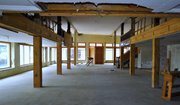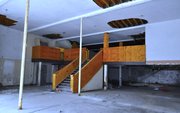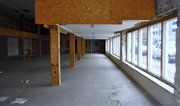This building, located at the corner of Farish and Amite streets, was under renovation by developer David Watkins for a B.B. King’s restaurant, but Watkins says foundation problems halted the project. Photo by Trip Burns.
When the David Watkins camp responded to the Jackson Redevelopment Authority's decision to cancel Watkins lease on the Farish Street Entertainment District project, it sent JRA a 10-page letter that outlined the setbacks. It was an effort to explain what had happened, when and what would happen next if Watkins is not involved in the project going forward.
Watkins may turn out to be right about the projects future—he says the project is "doomed" without him—but one of the biggest reasons he lists as a setback may not be anyone else's fault.
In that 10-page letter, dated Oct. 9, 2013, Watkins, through his attorney Lance Stevens, said: "The most significant delay resulted from the discovery in June of 2012 of the hidden structural defects in the B.B. King Building foundation. The engineering and construction solution to the newly discovered structural flaw resulted in increased costs of over $1.5 million and months of delay."
Stevens explained to the JFP last month in the run-up to a related story that the building passed one inspection before a subsequent inspection found that the foundation wasn't just lacking, but nonexistent.
But that may not be the whole story The company, and the individual engineer, who supposedly gave the building a pass during the first inspection, both deny that they inspected the building's foundation.
"We do not do foundation work or assess foundations," said CivilTech engineer Elmore Moody, who supposedly inspected the building for Farish Street Group. "We would need core drilling equipment that we do not use."
Watkins said Monday through email that he hired CivilTech for the purpose of evaluating whether the structural design of the building would support the additional weight from the expanded use of the new club on the third floor. Moody and CivilTech provided Watkins with computer-assisted designs, he said, which suggested that the building needed a new system of beams, joists and columns to support the additional load.
"Based on those designs," Watkins wrote "approximately $400,000 was expended on the structural support requirements." He added that neither the architectural drawings he received from his predecessor—Farish Street's former developer Performa—nor the report from CivilTech gave any indication any foundation issues. "Most certainly, the extensive structural work on the building that was completed was done based upon the recommendation," he concluded. "No recommendation was made by CivilTech, nor was there a suggestion made, that any additional engineering studies needed to be conducted, including any soil or foundation testing."
JRA Board President and New Horizon Church Pastor Ronnie Crudup said Friday that the first he heard of the foundation was when Watkins informed JRA of the building's structural problems about two years ago. "I, as well as, I'm sure, my fellow (board members) assumed that they had done their homework," Crudup said.
"Frankly, that's on their end of things."





